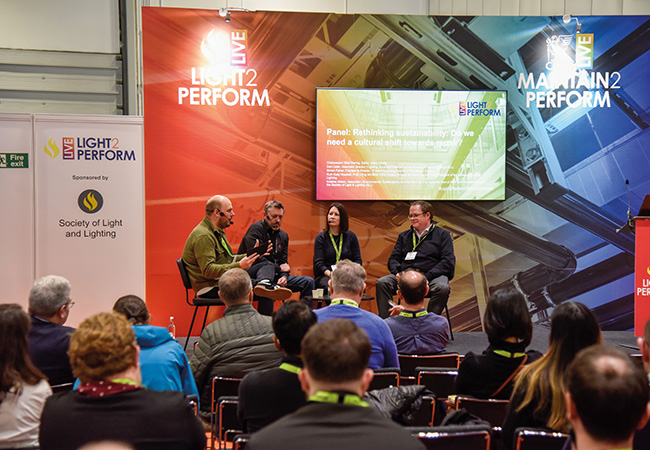
From left: Matt Waring, Simon Fisher, Kristina Allison and Dan Lister
The lighting industry is driving conversations around sustainability, circularity and repair, with growing recognition that real progress requires a cultural shift.
The topic was the subject of a panel session at the Light2Perform event, held at Build2Perform Live, chaired by Matt Waring, editor at [d]arc media.
Opening the discussion, Dan Lister, Society of Light and Lighting (SLL) president and Arup associate director, highlighted how clients are keen to retrofit their lighting with ‘large-scale LED upgrades’ – but the challenge is not just about deploying LEDs, but also about reducing their environmental impact, he said.
A key milestone has been the development of BS 8887, which focuses on remanufacturing, added Lister, who called it ‘a game changer’ for its ability to offer more consistent metrics for sustainability.
Simon Fisher, founder and director of F Mark, said he has seen a growing appetite for change over the past 10 years, but costs remain a barrier for many clients. He added that sustainability is becoming a more valid metric with the emergence of TM65.2 and TM66, which focus on embodied carbon calculations and circular economy principles respectively.
The conversation shifted to the practical application of circularity, particularly the reuse and refurbishment of lighting products. Lister shared Arup’s experience of refurbishing light fittings in its own offices, achieving an embodied carbon reduction of more than 80%. ‘It’s not as hard as everyone thinks it is,’ he said, adding that case studies are critical for building confidence among clients.
‘We’re conditioned to think that new is best,’ Fisher said. ‘We need to demonstrate through case studies that remanufactured products can deliver the same or better results.’ This cultural shift, he argued, is essential for scaling up reuse and repair.
Kristina Allison, associate at WSP, said circularity must be embedded into the design process: ‘It shouldn’t even be a question. It’s our responsibility as designers to make sustainability a core part of our work.’
The concept of lighting as a service emerged as a key topic. Fisher acknowledged its potential to monitor and report environmental benefits, but admitted: ‘It’s a nightmare to implement.’ He cited the complexity of ownership models, and the disconnect between specifiers, manufacturers and end users, as significant barriers.
Lister pointed out that design plays a vital role in sustainability, regardless of the delivery model. ‘The biggest impact on embodied and operational carbon is the design,’ he said. ‘It’s about finding the right solution for the space and avoiding over-provisioning.’ He explained that effective lighting solutions require a conscious approach to fitting design, placement, and embodied carbon savings, which are sometimes overlooked in favour of contractual and operational simplicity.
Allison agreed, emphasising the importance of focusing on people. ‘If the lighting isn’t for the people using the space, we don’t need it,’ she said, echoing the sentiment that sustainability must go hand in hand with human-centred design.
Education and legislation
Allison stressed the need for education, within the industry and among the public. ‘It’s about changing society’s attitudes,’ she said, citing night-light festivals and school engagement programmes as examples of how the industry can inspire the next generation.
Fisher shared his work on Scotland’s upcoming Circular Economy Bill. ‘On our first call with the Scottish government, the goal was clear: they never want to buy a new light fitting again,’ he said. While this might not be practical, Fisher emphasised the importance of considering reuse and remanufacture in all procurement decisions.
The panel concluded by discussing the role of organisations such as the SLL in driving forward sustainability. Again, Lister highlighted the importance of technical standards. ‘The rest of the world is looking at us,’ he said. ‘The way to make real change is to get these standards out there and make them more powerful.
‘Let’s not just drive for low carbon and low energy use and sacrifice the human aspect. More is less; put less light in. We need to make sure we are lighting in the right place at the right time.’


